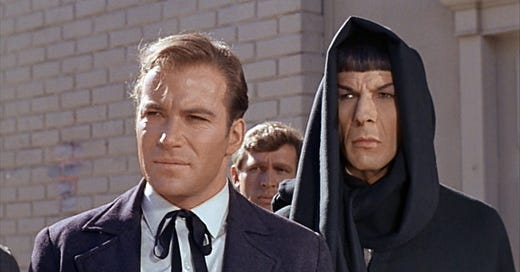Ghost in the Gadgetry
Right off the bat “The Return of the Archons” has a lot going for it. For starters, it was shot largely on the RKO Forty Acres lot, a veritable star around which orbited many famous Hollywood productions for screens large and small. Built to represent antebellum Atlanta and the Tara Plantation in Gone with the Wind, the set would ultimately be best known as the town of Mayberry from The Andy Griffith Show. The Tara set would ultimately be dismantled and sold to Betty Talmadge, ex-wife of former Georgia Governor and diehard segregationist Herman Talmadge. Herman is a bundle of stories all his own, not least of which is a part an tacky bit of anti-democratic political gamesmanship known as the three governors controversy, but Betty didn’t just hang off his arm like a pricey watch. If it has ever crossed your mind to go visit the “real” Tara near Jonesboro, you have Betty Talmadge to thank for the notion that such a place existed and that it existed there—both figments of her life’s campaign to establish a Tara theme park near her home. Ultimately I think she did us all a favor because when Jonesboro provided the key votes flipping Georgia into the blue column in the 2020 election it provided a sweet capper for the story of Mammy—as her descendants pushed that peach-colored flatulent TV boss out of the Whitehouse.
It’s a recurring theme: Once Tara had been cleared off the RKO lot, a swarm of Hollywood carpenters constructed the set for Hogan’s Heroes, in which a ragtag bunch of Allied P.O.W.s led by Bob Crane’s charismatic, wisecracking Colonel Hogan do their bit to push a meth-addled flatulent housepainter out of the Reich Chancellery. RKO Forty Acres has done its bit for king and country.
This isn’t the first time Forty Acres has graced the backdrop of a Star Trek episode. It made an appearance way back in episode 8, “Miri,” but, well, I don’t like “Miri” so I suppose I didn’t notice. Anyway, it’s fun to see an Enterprise away team walking through something that doesn’t look like it was constructed the previous afternoon out of old pizza boxes.
The away team in this instance is a doozy: Kirk, Spock, McCoy, a guy purporting to be a sociologist1 whose love-affair subplot would ultimately wind up on the cutting room floor only to appear much later in overlong asides plopped into windy excavations of trivia, and two red shirts. This is actually the calvary, come to the aid of the first away party—Sulu and another red shirt—who we see in media res at the beginning of the episode, sneaking around Mayberry looking for signs of a ship, the Archon, lost there a hundred years prior, before being attacked by mysterious cloaked figures. The red shirt takes off running like that pencil-shaped senator from Missouri that appeared in a swastika pose2 darting across a hallway in the Capitol on January 6. Sulu is beamed back to the ship exhibiting what look like signs of an ecstasy overdose.
So the big boys go to work. They arrive dressed hilariously in period costume—though what period it’s hard to say; Kirk is dressed like the bartender in a dusty old western, a curious floppy ribbon bowed at his throat. Spock is wearing a fucking cowl. He looks like Bengt Ekerot in The Seventh Seal, like he’s about to challenge some vain mortal to a 3-D chess game.
So thus attired they wander the streets for a few minutes, looking not at all suspicious packed tightly together in their fancy finery like a knot of hipsters in East St. Louis on a Saturday night. Suddenly—I mean, as suddenly as the arrival of any hour I suppose, so perhaps the word is “dramatically”—the camera zooms in on the town’s clocktower, its hands resting on six and twelve. A bell begins to toll and the townspeople go berserk—“wailing” on each other as the argot goes—if you’re up on your low-budget suspense-horror it’s basically The Purge but with a wardrobe suggesting all of an eighty-year period centered on 1900.
Finding themselves the target of a barrage of papier mâché bricks, our intrepid heroes make for the safety of a guesthouse hosted by Reger, played by Harry Townes looking strikingly like Felix Unger. Harry was a native of Huntsville, Alabama. I get that. I’m a native of Huntsville, too. I’m a native of lots of places and also of none. But I digress like a sumbitch.
Reger explains that he’s part of a secret underground movement fighting to remake his society—an autocracy led by someone or something named Landru. The chaos outside—“The Festival”—is a sort of ceremonial reversal like Carnival but with fewer boobs and the violence is state-sponsored. Like an NRA convention3.
Reger assumes that Kirk is an Archon returned to exact revenge for his people, defeated and assimilated by Landru a hundred years prior. Kirk realizes that the Archon was destroyed by some power on the planet to which the Enterprise might also be vulnerable. Placing a quick long-distance call he finds that the Enterprise is indeed being attacked by a heat beam and can neither escape nor retrieve the away team. About this time the hooded fellas that turned Sulu into a grinning idiot show up. They tell Kirk he’s gotta come with them but, kirking up his kirks, Kirk kirks, “No.” They’re flummoxed by this response, and we, the viewers, receive our first clue as to what’s really afoot.
The hoods leave but then Landru shows up, as a projection on the wall, looking much like a tall oompa-loompa. Landru causes them all to pass out by means of an annoying sound. They wake up in custody, from which they are marched off one by one to a chamber where they’re brainwashed by some electromechanical process. One of the red shirts gets zapped, and then, to our abject horror, presumably, McCoy. He comes back spouting stuff about peace and tranquillity and sounding just like the Sunday morning crowd at the cafe in downtown Toccoa in 1963. I know, right? What could be more horrifying that that?
When it’s Spock’s turn he’s escorted to the gallows room like the others but as soon as the hoods leave the brainwashing guy reveals that he’s in league with Reger. With their help Kirk the Gang get into Landru’s inner sanctum, confirming the conclusion they’d already reached, that Landru is in fact a computer. A computer programmed by the real Landru, it emerges, some 6,000 years earlier.
Much as in the last episode we are then treated to Star Trek’s somewhat orthogonal intersection with the field of computer science. Artificial intelligence in 1967 was epitomized by ELIZA4, an early chatbot that mimicked a psychoanalyst reflecting it’s interlocutor’s statements back at him or her. It’s cute but limited:
> Hello, I am Eliza. I'll be your therapist today.
* I'm writing an essay in which you are mentioned.
> What makes you think I am mentioned?
I was going to compare ELIZA with a modern chatbot but I can’t get goddamn ChatGPT to do anything funny. ChatGPT seems at first blush different from ELIZA but if you stick with one subject long enough it’s easy to spot the moment the conversation comes around to bite its own tail in a frustrating circle. I suppose the confrontation with Landru captures something of this mechanical insistence as it asserts that its model of society is the best because it prioritizes peace above all else, but in the end it’s the machine that gets frustrated as Kirk leads it by the microchip, explaining that it can’t be a benefit to society because the society it has made is creatively dead.
It’s a fair point but I can’t imagine why the machine would see it that way, or why it would give a shit. This is a system that has survived virtually unchallenged for six millennia, after all. Yet giving a shit is exactly what it does—so blindingly intense a shit, in fact, that the computer literally blows up. This wouldn’t be the last time that a computer on Star Trek fails when presented with a contradiction. In the same way your home electrical system can be shorted by ramming a staple into a wall socket5, the intelligences of the future—1967’s future—could be shorted out by ramming an idea into them.
By way of contrast, I tried telling ChatGPT “this sentence is a lie” and it merely explained paradoxes to me. Can you imagine what it’s going to be like when these things are running phone trees? You’ll be screaming that your rented Honda is stuck perpendicular across three lanes on the Connector6 at the height of rush hour and for the love of all that is holy can you talk to a human and it will softly explain the evolution of homo sapiens to you.
I’d love to say that “Return of the Archons” is a cautionary tale about artificial intelligence run amok but honestly the future isn’t what it used to be—I worry more about AI magnifying the stupidity and malevolence of the worst of us more than its independent emergence as a digital overlord. What it does do well is to paint a portrait of a lifeless autocracy: the often well-meaning intentions that spawn them, the furtive subversions that rise in spite of them, the crude safety valves intended to dilute or mute or distract from those countercurrents. There was at that time still plenty of memory of the worst that such societies could produce—the wounds were still fresh in 1967.
Would those wounds have been worse had they been inflicted by an AI instead of a bunch of Teutonic maniacs? I don’t suppose it makes much difference, but an AI in the hands of Teutonic maniacs wouldn’t have been great. Computers do, after all, what all tools do: they provide leverage to human operators, and if the human operator wants to use them to bludgeon other humans into submission, they will cheerfully comply. All this talk of sentience, aside from being laughable bullshit—Large Language Models are no more sentient than a dishwasher or a refrigerator—draws a lot of attention away from whoever is about to become filthy rich enough to bend our political system into a pretzel. That to me is the great irony of “Return of the Archons”—the big reveal is that the man behind the curtain is a machine. But machines don’t grow on stalks—there’s got to be another curtain, and another man.
Actor Christopher Held, who holds an increasingly rare distinction amongst Trek alums— still being alive, at the ripe old age of 91.
You know, like running.
Yes, there are a lot of boobs at an NRA convention. I’m glad we could share this little homonym together.
In case it needs to be said, don’t do this.
For those of you not in Atlanta, this is a famous 42-lane Atlanta parking lot.




